October 14, 2025
If you use a field service management software for your pest control business, you already know that time is money.
Every extra mile your technicians drive or every late appointment adds up to wasted hours and lost revenue. That’s where intelligent scheduling and route optimization come in.
Instead of juggling paper calendars and relying on guesswork, exterminators can utilize mobile tools to plan the most efficient routes and assign jobs more effectively.
The result? Less driving, more completed jobs, and happier customers who feel taken care of.
It also reduces technician burnout, saves on fuel costs, and keeps your team organized throughout the day. With the right tools, scheduling becomes smoother, and your business runs more profitably and professionally.
Pest Control Scheduling & Route Optimization: Tools for Faster Service
If you’re running a pest control business, you already know the day can turn on a dime. One minute, the schedule looks neat, and the next, you’re juggling a last‑minute termite swarm, a wasp emergency, and a tech calling in from the field asking for updated directions.
That’s why pest control scheduling software and route optimization matter so much for exterminators today.
When the calendar, the crew, and the routes all click into place, everything else gets easier. Jobs finish on time. Customers stay happy. Cash comes in faster.
This guide explains how pest control software, including pest scheduling and pest control routing software, enables teams to move quickly, reduce waste, and deliver smoother customer experiences.
We’ll look at the tools to consider, must‑have features, and practical steps to roll it out without disrupting your day.
Key Takeaways
- Scheduling and route optimization cut drive time, reduce fuel spend, and help technicians complete more jobs per day.
- The best pest control business software integrates job scheduling, route planning, compliance logs, and customer communications, ensuring that office operations and field teams stay aligned.
- Look for a drag-and-drop scheduler, automated reminders, mobile app access, and optimized routes to avoid missed appointments and scheduling conflicts.
- Start small with a pilot, track real-time data on drive time and technician efficiency, then scale across crews for consistent results.
Why Scheduling and Routing Matter in Pest Control
Most pest control companies face the same daily challenges: long drives between stops, last-minute rescheduling, and recurring visits that require precise timing.
Add specialized constraints, such as chemical handling rules and technician certifications, and the puzzle becomes even more challenging.
- Operational pain points: Travel time accumulates, recurring service windows are missed, and multi-stop routes become a headache without the right tools.
- The business impact: More time in traffic means fewer jobs per tech. That translates into higher fuel costs, extra vehicle wear, and lower customer satisfaction. When routes are optimized and job management is tight, teams stay organized, technicians finish more jobs, and customers get a smoother customer experience.
What are the Common Scheduling Challenges for Exterminators
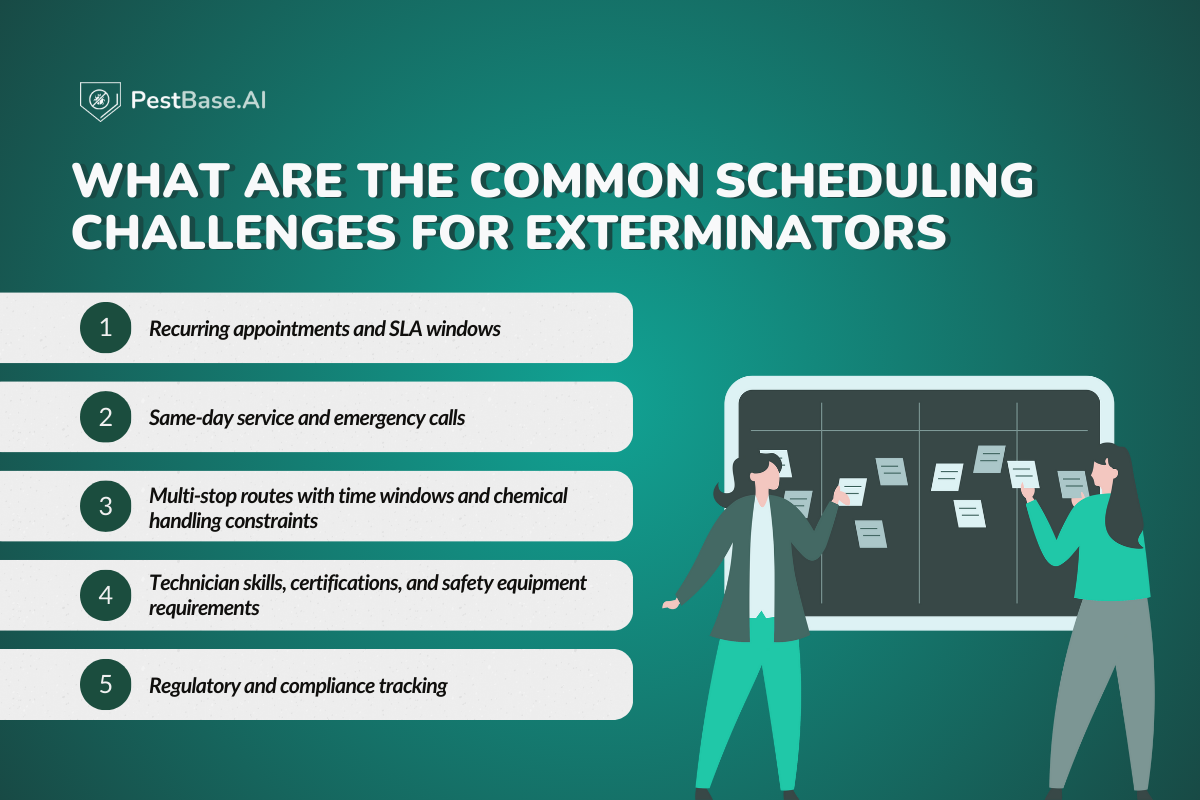
1. Recurring appointments and SLA windows
Monthly, bi‑monthly, and quarterly services demand precise time windows to keep customers satisfied and pest activity controlled.
2. Same‑day service and emergency calls
Bee or wasp nests can’t wait. Fitting urgent jobs into an already packed day requires dynamic route changes.
3. Multi-stop routes with time windows and chemical handling constraints
Not all stops can be accommodated at any location. Certain pest types or treatments need specific sequencing or timing.
4. Technician skills, certifications, and safety equipment requirements
Not every tech can handle every job. Scheduling software should match jobs with certified pest control operators who have the right equipment.
5. Regulatory and compliance tracking
Labels, usage logs, and inspection records must be connected to the scheduled work for easy audits later.
Types of Tools & Tech in Pest Scheduling

- Basic calendars and spreadsheets: Fine for tiny businesses, but they require heavy lifting from office staff and break under pressure.
- Dedicated pest scheduling software: Built for pest control operations, linking job scheduling, route optimization, compliance, and customer information in one place.
- Route planning platforms and last-mile routing engines: Optimize multi-stop technician routes, reduce drive time, and facilitate depot returns.
- Mobile dispatch apps for field technicians: Technicians carry their job info in their pocket-safety checklists, client signatures, photos, and notes. No paper forms, no guessing, and everything is updated in real time.
- CRM and billing integrations: Technicians can see which customers are recurring and know invoices are being handled automatically. This means less chasing payments, more focus on servicing clients.
- Telemetry and GPS fleet tracking: Office staff can guide techs if needed, but more importantly, techs get accurate arrival times, optimized routes, and less wear on vehicles, so they spend more time solving problems and less time stuck in traffic.
How Route Optimization Works for Pest Control
At a high level, route optimization balances distance, time windows, service lengths, and constraints like depot returns or chemical resupply.
The system assigns optimized routes for each technician, updating in real-time if a cancellation occurs or an emergency job arises.
Short explainer:
Think of routing like solving a sliding puzzle with real-world rules. The system examines each stop’s promised time window, adds realistic travel buffers, and considers the typical duration of each service, whether it’s a quick ant follow-up or a full-termite treatment.
It also schedules breaks so techs don’t get slammed back-to-back all day.
In pest control, there’s an extra layer: in depot visits for chemical resupply, safe handling rules, and regional traffic patterns that change by hour.
Together, the algorithm builds a route that’s fast, safe, and actually doable, improving daily operations.
Use cases:
- Recurring customers matched to specific techs
When a customer prefers the same technician and you have a quarterly plan on the books, the system keeps her on that technician’s route and slots the visit into the right cadence. It respects her preferred time window and stacks nearby stops to cut dead miles.
- Same-day emergencies with minimal disruption
A hornet nest pops up at noon, and the phones light up. Instead of blowing up the whole schedule, you drop the emergency into the nearest qualified tech’s route.
The system reshuffles just a few stops, updates ETAs automatically, and keeps everyone informed.
- Multi-tech coordination for large commercial accounts
For big sites, think warehouses, campuses, or multi-building complexes, you can assign multiple techs with different certifications.
The plan staggers arrival times, sequences interior and exterior treatments properly, and ensures that any required depot resupply occurs between phases, not during a task.
If you think you dont need Pest control Software, then you are wrong. You must have a look at this: Pest Control Software vs Manual Scheduling: Why It Matters.
What are the Must-Have Features in Pest Scheduling Software
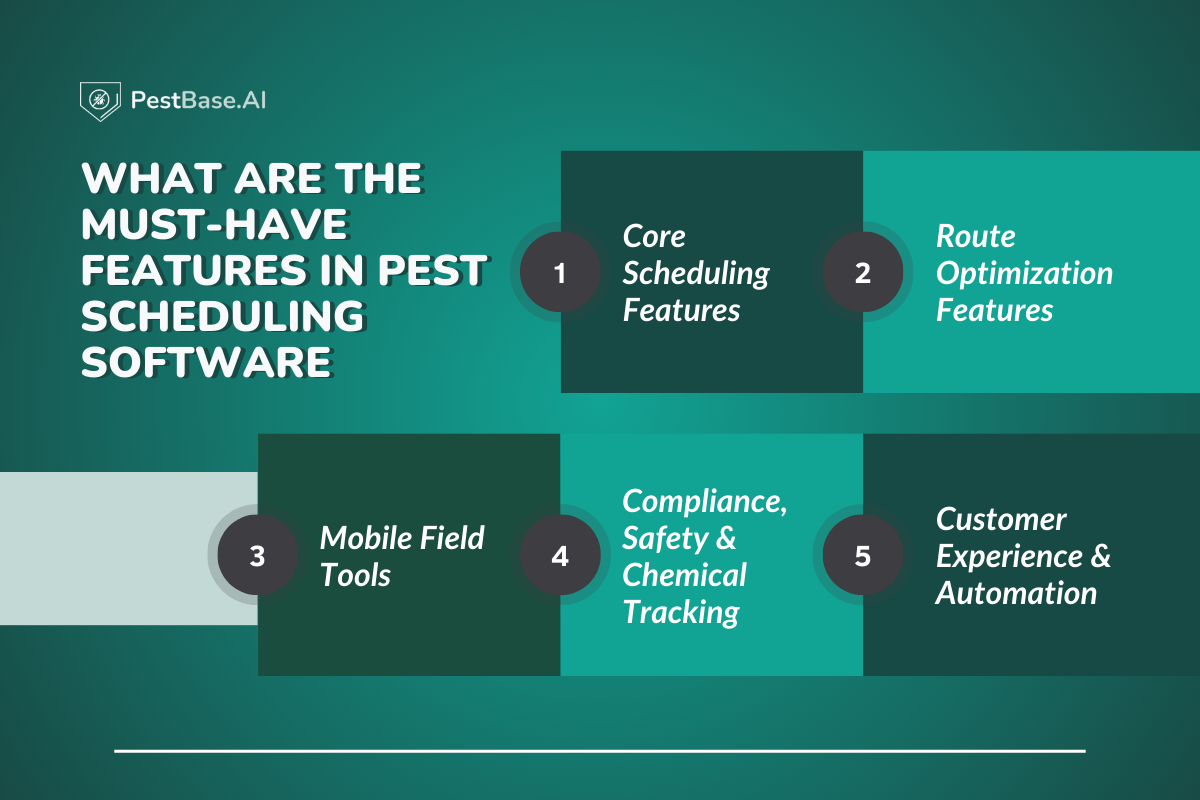
Choosing pest scheduling software means keeping days smooth, technicians on time, and customers happy with practical sales tools.
Here’s a quick look at the must-have features that make scheduling easier, routes more innovative, and operations way more efficient.
Core Scheduling Features
- Drag-and-drop schedule board and crew availability: A drag-and-drop scheduler will help your office staff to quickly adjust jobs without rebuilding the entire day.
- Recurring job templates and SLA enforcement: Prebuilt templates ensure consistent service cadence and help prevent missed appointments.
- Time windows, service length estimates, and travel buffers: These ensure schedules are realistic to prevent technicians from falling behind by noon.
Route Optimization Features
- Multi-stop route builder with time window awareness: Create optimized routes across dozens of stops without guesswork.
- Dynamic re-routing for traffic, cancellations, or emergencies: Drop appointments into live routes and automatically recalculate technician routes.
- Depot and chemical supply constraints: Include resupply points, hazardous goods rules, and job ordering for safety and compliance.
Mobile Field Tools
- Offline-capable technician app: Access job details, safety checklists, and MSDS resources even without a signal. Syncs job progress and photos when reconnected.
- Real-time ETA, on-my-way notifications, and photo reports: Improve customer communications and reduce no‑shows with accurate ETAs and visual proof of work.
Compliance, Safety & Chemical Tracking
- Digital pesticide logs and usage tracking per job: Maintain organized records for audits and regulatory inspections.
- MSDS access and automated audit trails: Reduce liability and simplify the production of exportable compliance reports.
Customer Experience & Automation
- Automated reminders and rescheduling links: Fewer missed appointments with two‑way SMS and email confirmations.
- Customer portal for recurring service: Customers can update appointments, review job history, leave more customer reviews, and pay online for faster billing.
The global pest control software market reached $1.9 billion in 2024 and is expected to hit $4.5 billion by 2033, growing at a CAGR of 10.2% (2026–2033)
How to Choose the Right Pest Scheduling Software
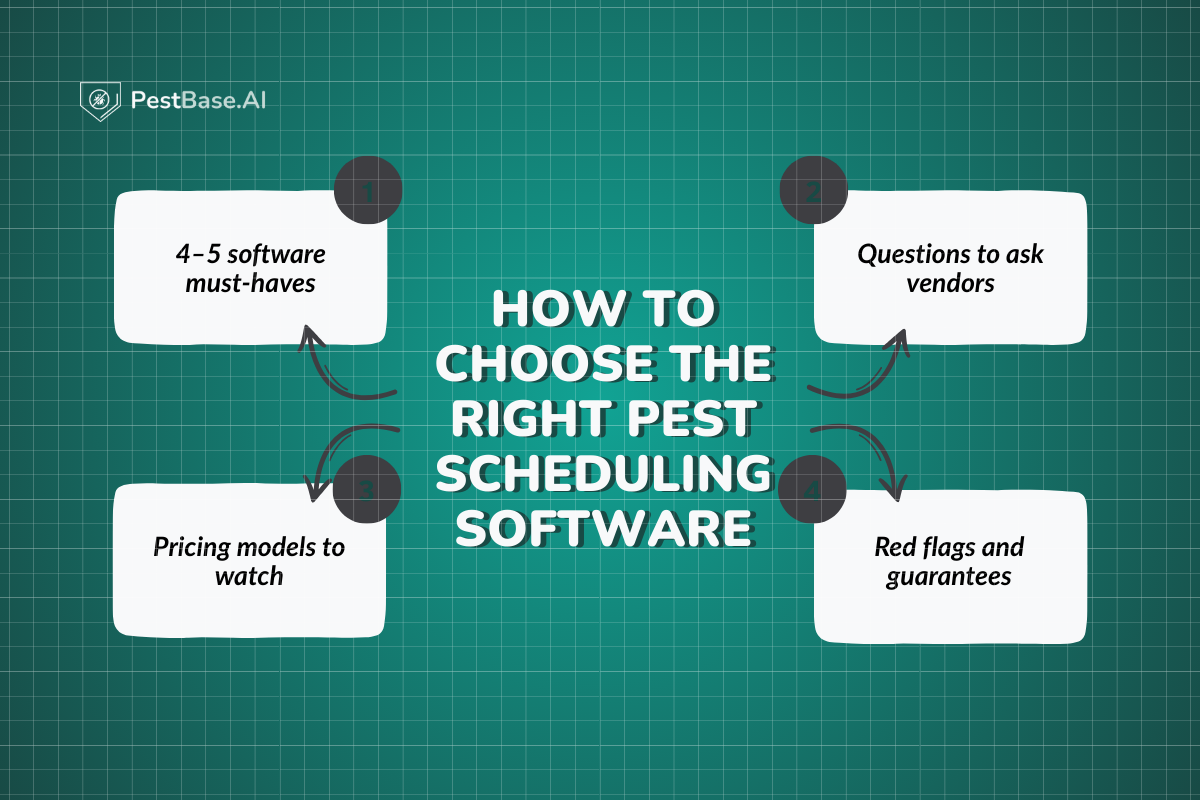
When evaluating pest control software tools, stay focused on what matters most: simpler scheduling, smoother routes, faster communication, and clear compliance.
- Must‑have key software features: Drag and drop scheduling, route optimization, mobile app with offline mode, chemical tracking, CRM, and accounting integrations.
- Questions to ask vendors:
- How easy is the mobile app for techs who are heads‑down in the field?
- Can the system handle recurring job templates and SLA windows?
- How are pesticide logs, MSDS, and usage tracked per job?
- What integrations are available for QuickBooks/Xero, fleet GPS, and inventory management?
- What does onboarding and support look like for small businesses?
- Pricing models to watch: Per‑tech, per‑job, or flat subscription. Balance cost with the features you’ll use daily.
- Red flags and guarantees: Look for clear data export options, uptime guarantees, role permissions, and a transparent roadmap.
How You Truly Benefit from Route Optimization
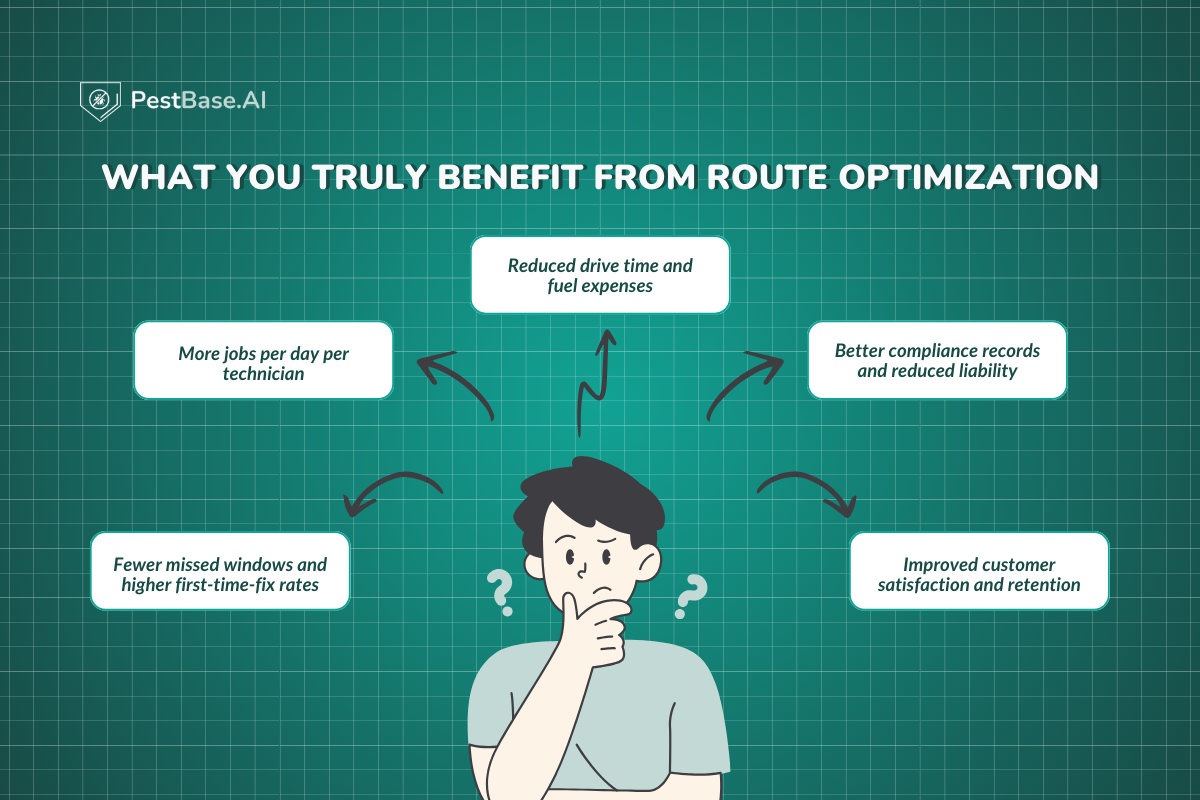
Here’s what really changes when scheduling and routing click into place. It’s not just smoother days for the office, it’s faster routes, happier techs, and new customers who feel taken care of at every step. Minor tweaks here lead to big wins everywhere.
1. Reduced drive time and fuel expenses
Optimized routes shave off unnecessary miles and idling. That means lower fuel bills, less vehicle wear, and more time spent serving customers instead of sitting in traffic.
2. More jobs per day per technician:
When routes flow and time windows are realistic, techs move from one stop to the next without bottlenecks. The result is a fuller day’s work without the burnout.
3. Fewer missed windows and higher first-time-fix rates:
Clear time buffers and solid prep cut the last-minute scramble. Techs arrive ready, with the right materials and notes, so more jobs are completed correctly on the first visit.
4. Better compliance records and reduced liability:
Digital pesticide logs and usage tracking keep everything tidy and searchable. Audits feel less like a fire drill when paperwork is already organized and exportable.
5. Improved customer satisfaction and retention:
Automated reminders and accurate ETAs keep customers informed. A simple portal for rescheduling and payments turns a good visit into an extraordinary experience they’ll want to repeat.
Implementation Roadmap for Pest Control Teams
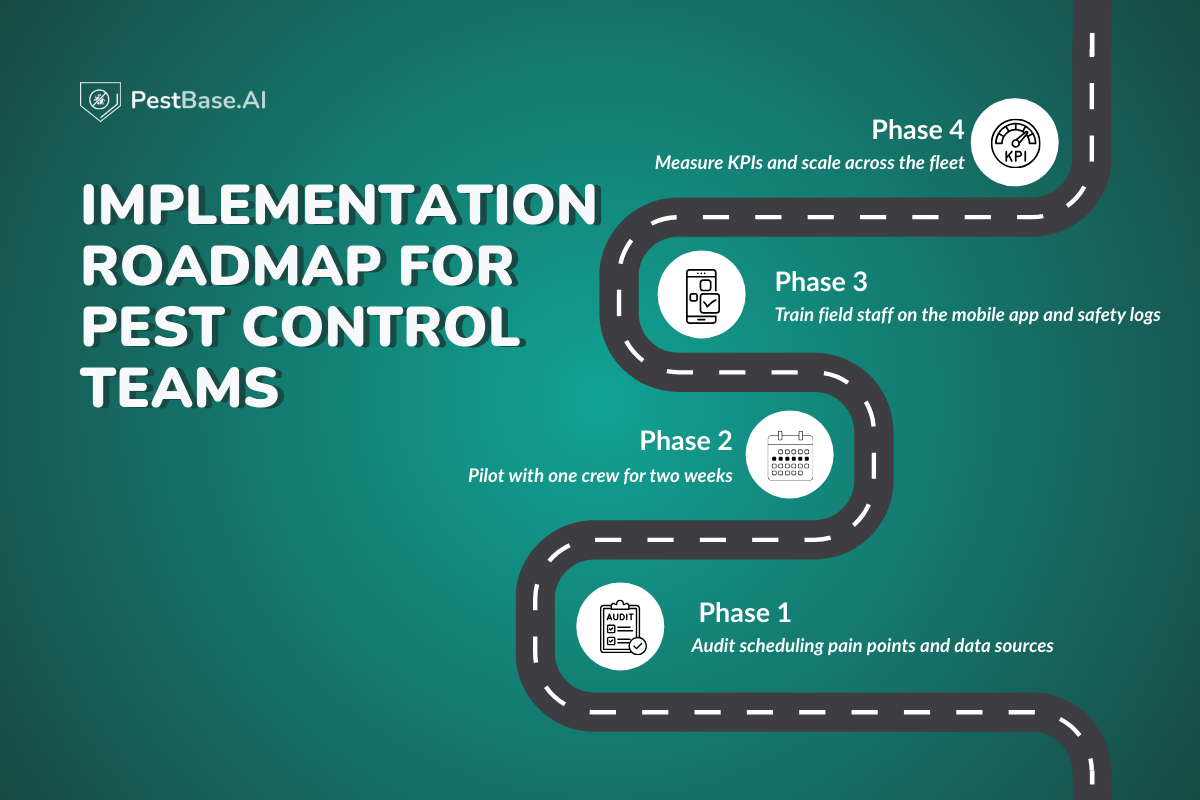
Here’s a simple way to roll out scheduling and routing without derailing the day. Start small, learn fast, and scale what works. Think of it like tightening bolts on a busy truck: quick passes, real data, and steady improvements week by week.
Phase 1: Audit scheduling pain points and data sources
Map out your current process, from the initial call to completion. Then flag repeat headaches associated with specific routes, tight time windows, and seasonal spikes.
Pull basic data on drive time, no‑shows, reschedules, and average jobs per tech to set a clear baseline.
Phase 2: Pilot with one crew for two weeks
Pick a single crew and territory. Build optimized routes, stick to realistic time windows, and capture results daily.
Also, track drive time, missed appointments, and jobs per tech per day so you can compare before and after without guesswork.
Phase 3: Train field staff on the mobile app and safety logs
Keep training short, hands‑on, and tied to real work. Walk techs through job details, photo capture, MSDS access, and e‑sign. Show how “on my way” texts and ETAs to reduce no‑shows and make their day run smoother.
Phase 4: Measure KPIs and scale across the fleet
Review results weekly with the team. Adjust routing rules, time buffers, and resupply stops according to what you have learned.
Roll out to more technicians in waves, maintaining the same KPI checklist to ensure improvements remain consistent.
In 2025, 52% of pest control companies in the U.S. reported using routing software, reflecting significant industry adoption aimed at improving scheduling and technician efficiency.
How can you measure ROI
A sound system should pay for itself fast. The easiest way to prove it is to track a few key numbers before and after the rollout, then perform a quick back-of-the-envelope calculation each month.
KPIs to track
- Drive-time reduction: Track how many minutes each technician saves on routes daily; it adds up fast.
- Jobs per tech per day: See how many extra stops get done without stretching into overtime.
- Fuel spend: Measure how much money you’re saving each week or month thanks to smarter routes.
- SLA compliance: Monitor on-time arrivals and reduce missed appointments to meet customer promises.
- Churn rate: Track the number of customers who stick around versus those who cancel or don’t renew.
- Average customer reviews: Follow your star ratings and the frequency of new reviews.
Payback period:
Compare monthly software costs to:
- Fuel savings from fewer miles and less idling.
- Revenue from extra jobs completed per tech per day.
- Savings from fewer missed appointments and return visits.
- If daily use is consistent, most field service teams see payback within a few weeks, followed by ongoing gains month after month.
Quick formula to keep handy: Monthly ROI = (Fuel savings + Extra job revenue + Fewer missed window savings) − Software cost
Tip: Log these metrics in a simple sheet for the first 30 days. Share the wins with your team so everyone sees how their new habits are paying off, including with potential customers.
If you are wondering how to choose a Pest Control CRM, here's the perfect guide for you: What to Look For in Pest Control CRM Software
Here are some Scaling & Advanced Tips
Here’s how to level up once the basics are solid. Think smarter territories, automation that works quietly for you, and greener routes that save you money.
These tweaks help teams move faster without adding stress to the day while also creating cross-sell opportunities.
Territory planning and workload balancing
Group nearby neighborhoods and commercial accounts under the same techs to reduce cross‑town drives and protect response times. Review workloads weekly so no one’s overloaded while another route has gaps.
Automation for recurring revenue
Set subscription plans with auto‑renewals and scheduled reminders so the routine visits never slip through the cracks. Let the system handle renewals and notifications, while your team focuses on higher-value tasks.
Eco-routing
Pick routes that cut idle time and unnecessary miles while still meeting time windows and SLAs. It’s easier on fuel budgets and vehicles, and it’s a simple way to make operations more sustainable.
What makes PestBase the top choice software for Scheduling & Route Optimization for Exterminators?

PestBase is a software designed to do the heavy lifting behind the scenes so teams can focus on service.
It integrates pest control scheduling software, routing software, and compliance tracking into a single, user-friendly system for office staff and field teams.
- Drag-and-drop scheduler: Move jobs around in seconds, apply recurring job templates, and keep the whole day balanced.
- Optimized routes: Build multi‑stop routes with time windows and dynamic re‑routing for emergencies, traffic, or cancellations.
- Mobile app built for techs: Offline mode, job details, MSDS access, photo capture, e‑signatures, and automated on‑my‑way notifications.
- Compliance first: Digital pesticide logs, usage tracking per job, and exportable reports give you clean records for inspections.
- Customer experience: Easily send automated reminders, a customer portal for recurring accounts, online payments, and clear job progress updates.
- Integrations: CRM and billing sync, QuickBooks/Xero, inventory management, and GPS fleet tracking, so your business management software stays connected.
- Insights that matter: Route efficiency dashboards, technician efficiency reports, and SLA performance so you can save time and increase sales with real data.
- Proposal & Estimate Builder: This feature lets you create clean, branded proposals and estimates in minutes. Auto-fill customer info, services, and pricing, then send them out for e-signature, no extra steps.
- Invoicing & Payments: By using PestBase, you can send branded invoices on the spot, accept digital payments, track payment status, and sync everything to your accounting tools to avoid double data entry.
PestBase helps pest control professionals stay organized, win more customers, and deliver unparalleled customer experiences without adding more to the office team.
For small businesses and growing teams alike, it’s the best software to transform scheduling chaos into clean, repeatable workflows that generate more leads.
Conclusion
Scheduling and route optimization sit at the heart of successful pest control operations. When routes are optimized, job management is efficient, schedules are realistic, and the mobile app keeps everyone on the same page; ultimately, everything speeds up.
Technicians handle more jobs. Customers get timely updates and dependable service. Compliance paperwork stops dragging you down.
If smoother routes, fewer missed appointments, and faster billing sound good, now’s the time to try pest control business software built for field service. Start with a short pilot, track your KPIs, and expand once you see the gains.
Ready to reduce drive time, complete more jobs, and keep your business organized?
Book a demo to see how PestBase helps you by offering a free demo to handle scheduling, optimized routes, compliance, and customer communications in one platform.
FAQs:
What is pest scheduling software?
It’s a tool that simplifies job scheduling, route optimization, and technician dispatch for pest control operations, often including automated reminders, compliance tracking, and online payments.
How does route optimization help exterminators?
Optimized routes reduce drive time and fuel costs, improve on‑time arrivals, and increase the number of jobs a technician can complete in a day.
Can pest control software help with compliance?
Yes. Pest control management software typically includes digital pesticide logs, MSDS access, and usage tracking per job, as well as exportable reports for audits.
Will my technicians need training?
A short hands‑on session is usually enough. Look for a simple mobile app that supports offline use and provides techs with precise job details and checklists.
